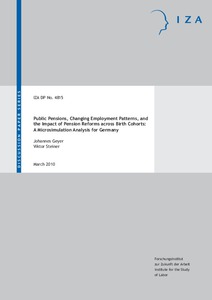Public pensions, changing employment patterns, and the impact of pension reforms across birth cohorts: a microsimulation analysis for Germany

Geyer, Johannes ; Steiner, Viktor
Institute of Labor Economics, Bonn
IZA - Bonn
2010
43 p.
life cycle ; pension reform ; pension scheme ; statistics
Discussion Paper Series
4815
Social protection - Old age benefits
English
Bibliogr.
"We analyze the impact of changing employment patterns and pension reforms on the future level of public pensions across birth cohorts in Germany. The analysis is based on a rich dataset that combines household survey data from the German Socio-Economic Panel Study (SOEP) and process-produced microdata from the German pension insurance. A microsimulation model is developed which accounts for cohort effects in individual employment and unemployment and earnings over the lifecycle as well as the differential impact of recent pension reforms. Cohort effects for individuals born between 1937 and 1971 vary greatly by region, gender and education and strongly affect lifecycle wage profiles. The largest effects can be observed for younger cohorts in East Germany and for the low educated. Using simulated life cycle employment and income profiles, we project gross future pensions across cohorts taking into account changing demographics and recent pension reforms. Simulations show that pension levels for East German men and women will fall dramatically among younger birth cohorts, not only because of policy reforms but due to higher cumulated unemployment. For West German men, the small reduction of average pension levels among younger birth cohorts is mainly driven by the impact of pension reforms, while future pension levels of West German women are increasing or stable due to rising labor market participation of younger birth cohorts."
Digital
The ETUI is co-funded by the European Union. Views and opinions expressed are however those of the author(s) only and do not necessarily reflect those of the European Union or the ETUI.